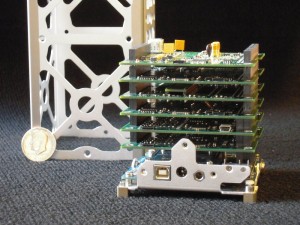Home » News » NASA Announces Fourth Round of CubeSat Space Mission Candidates
News
NASA Announces Fourth Round of CubeSat Space Mission Candidates
Posted by Andrew Sternberg on Wednesday, February 27, 2013 in News.
NASA ANNOUNCES FOURTH ROUND OF CUBESAT SPACE MISSION CANDIDATES
WASHINGTON — NASA has selected 24 small satellites to fly as auxiliary payloads aboard rockets planned to launch in 2014, 2015 and 2016. The proposed CubeSats come from universities across the country, a Florida high school, several non-profit organizations and NASA field centers.
CubeSats belong to a class of research spacecraft called nanosatellites. The cube-shaped satellites measure about 4 inches on each side, have a volume of about 1 quart, and weigh less than 3 pounds.
The selections are from the fourth round of the CubeSat Launch Initiative. After launch, the satellites will conduct technology demonstrations, educational research or science missions. The selected CubeSats will be eligible for flight after final negotiations and an opportunity for flight becomes available.
The following organizations submitted winning satellite proposals:
— The Aerospace Corporation, El Segundo, Calif.
— The Discovery Museum and Planetarium, Bridgeport, Conn.
— Embry-Riddle Aeronautical University, Prescott, Ariz.
— Morehead State University, Morehead, Ky., in partnership with the University of California at Berkeley
— Montana State University, Bozeman (2 CubeSats) in partnership with The University of New Hampshire, Durham
— Merritt Island High School, Florida, in partnership with California Polytechnic State University, San Luis Obispo
— NASA’s Ames Research Center, Moffett Field, Calif.
— NASA’s Goddard Space Flight Center, Greenbelt, Md. (3 CubeSats)
— NASA’s Jet Propulsion Laboratory, Pasadena, Calif., in partnership with the California Institute of Technology, Pasadena (3 CubeSats)
— NASA’s Kennedy Space Center, Florida
— Pennsylvania State University, in partnership with the Naval Research Laboratory, Monterey, Calif., and the Aerospace Corporation, El Segundo, Calif.
— Saint Louis University, St. Louis
— Tyvak Nano-Satellites Systems, Irvine, Calif., in partnership with the California Polytechnic State University, San Luis Obispo
— University at Buffalo, The State University of New York
— University of Colorado, Boulder
— University of Florida, Gainesville, in partnership with Stanford University
— University of Maryland, Baltimore County
— University of Texas, Austin
— Vanderbilt University, Nashville, Tenn., in partnership with the Radio Amateur Satellite Corporation, Silver Spring, Md.In the three previous rounds of the CubeSat initiative, NASA has selected 63 missions for flight. The agency’s Launch Services Program Educational Launch of Nanosatellite (ELaNa) Program has launched 12 CubeSat missions. This year, 22 CubeSat missions are scheduled for flight.
For additional information on NASA’s CubeSat Launch Initiative program, visit:
For information about NASA and agency programs, visit:
For information about CubeSat development at Vanderbilt University and the Institute for Space and Defense Electronics, visit:
Tags: AMSAT-NA, CubeSat, ISDE, NASA, Radiation Effects, Reed, Weller

Connect with ISDE
©2025 Vanderbilt University ·
Site Development: University Web Communications